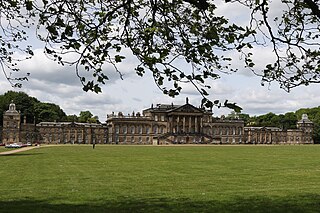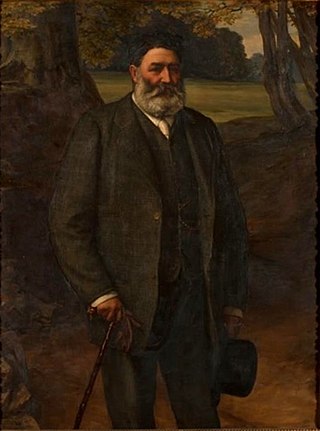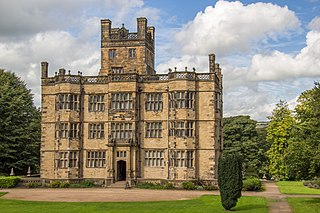
Wentworth Woodhouse is a Grade I listed country house in the village of Wentworth, in the Metropolitan Borough of Rotherham in South Yorkshire, England. It is currently owned by the Wentworth Woodhouse Preservation Trust. The building has more than 300 rooms, although the precise number is unclear, with 250,000 square feet (23,000 m2) of floorspace. It covers an area of more than 2.5 acres (1.0 ha), and is surrounded by a 180-acre (73 ha) park, and an estate of 15,000 acres (6,100 ha).

Harewood House is a country house in Harewood, West Yorkshire, England. Designed by architects John Carr and Robert Adam, it was built, between 1759 and 1771, for Edwin Lascelles, 1st Baron Harewood, a wealthy West Indian plantation and slave-owner. The landscape was designed by Lancelot "Capability" Brown and spans 1,000 acres (400 ha) at Harewood.

Harewood is a village, civil parish, former manor and ecclesiastical parish, in West Yorkshire, England, today in the metropolitan borough of the City of Leeds. The civil parish population at the 2011 census was 3,734.

George Henry Hubert Lascelles, 7th Earl of Harewood,, styled The Honourable George Lascelles before 1929 and Viscount Lascelles between 1929 and 1947, was a British classical music administrator and author. He served as director of the Royal Opera House, chairman of the board of the English National Opera (ENO) (1986–95); managing director of the ENO (1972–85), managing director of the English National Opera North (1978–81), governor of the BBC (1985–87), and president of the British Board of Film Classification (1985–96).

John Carr (1723–1807) was a prolific English architect, best known for Buxton Crescent in Derbyshire and Harewood House in West Yorkshire. Much of his work was in the Palladian style. In his day he was considered to be the leading architect in the north of England.

Henry Thynne Lascelles, 4th Earl of Harewood, was a British peer and the son of Henry Lascelles, 3rd Earl of Harewood.

Gawthorpe Hall is an Elizabethan country house on the banks of the River Calder, in Ightenhill, a civil parish in the Borough of Burnley, Lancashire, England. Its estate extends into Padiham, with the Stockbridge Drive entrance situated there. The house is traditionally attributed to Robert Smythson. In the mid-19th century, the hall was rebuilt by Charles Barry, the architect of the Houses of Parliament. Since 1953 it has been designated a Grade I listed building. In 1970 the 4th Lord Shuttleworth gave the hall to the National Trust, with a 99-year lease to Lancashire County Council. Both bodies jointly administer the hall and in 2015 the council provided £500,000 funding for restoration work on the south and west sides of the house.

Plompton is a hamlet and civil parish south of Harrogate in North Yorkshire, England. It is close to the A661.

Goldsborough is a village and civil parish in the Harrogate district of North Yorkshire, England. It is situated near the River Nidd and one mile (1.6 km) east of Knaresborough. Goldsborough is recognised by the well-known stately home Goldsborough Hall and its other features including: Goldsborough Primary School, the Bay Horse Inn and the Goldsborough Cricket Grounds.
Sir Richard Redman was an English nobleman, knight, administrator and politician, being elected as a Member of Parliament representing Yorkshire and later acting as the Speaker of the House of Commons for the Parliament of 1415.

Goldsborough Hall is a Jacobean stately home located in the village of Goldsborough, North Yorkshire, England. It is a member of the Historic Houses Association. The house itself is a Grade II* listed building. The Hall was built for Sir Richard Hutton (1560–1639) after he acquired the Goldsborough Estate in 1598, and in the 20th century it was home to Princess Mary, Countess of Harewood as her first family home.

Sir John Cutler, 1st Baronet (1603–1693) was an English grocer, financier and Member of Parliament.

All Saints' Church is a 15th-century redundant church in the park of Harewood House, the seat of the Lascelles Earls of Harewood, near the village of Harewood, West Yorkshire, England. It is recorded in the National Heritage List for England as a designated Grade I listed building, and is under the care of the Churches Conservation Trust. The church stands in isolation within Harewood Park, as the surrounding village was relocated by the owner of Harewood House, in about 1760, to a location further from the house. Inside the church is the family vault of the Earls of Harewood and a set of six alabaster monuments, which are "the largest collection of alabaster monuments in a parish church within the dates 1419–1510".

Browsholme Hall is a privately owned Tudor house in the parish of Bowland Forest Low in the borough of Ribble Valley, Lancashire, England. It is claimed to be the oldest surviving family home in Lancashire. Since 1954, it has been designated a Grade I listed building by English Heritage.

Edmund Boulter, was a London merchant and politician. He was the eldest son of John Boulter, a maltster, twice mayor of Abingdon and his wife born Susannah Cutler, sister of Sir John Cutler, 1st Baronet, later Edmund's business partner.
William de Aldeburgh, 1st Baron Aldeburgh was a 14th-century English nobleman and the builder of Harewood Castle.
Ightenhill is a civil parish in the borough of Burnley, Lancashire, England. The parish contains 15 buildings that are recorded in the National Heritage List for England as designated listed buildings. Of these, two are listed at Grade I, the highest of the three grades, and the others are at Grade II, the lowest grade. The parish is partly rural, and partly residential as a district of the town of Burnley. The most notable buildings in the parish are Gawthorpe Hall and its Great Barn. These are both listed, as are structures associated with them. The other listed buildings include a farmhouse dating from the 16th century, a former schoolmaster's house, a parish church and its churchyard wall, a drinking fountain, and two boundary stones.

Rougemont Castle in the manor of Harewood, in the parish of Weeton, North Yorkshire, England, is a ruined ringwork castle, now largely hidden within over-grown woodland, located to the south east of the village of Weeton, above the north bank of the River Wharfe, where the river turns in a right-angle at its confluence with Weeton Beck. No above-ground structure survives but the earthwork features remain visible of building platforms, ditch system, outer enclosure and fish ponds.
Harewood, West Yorkshire is a civil parish in the metropolitan borough of the City of Leeds, West Yorkshire, England. It contains 104 listed buildings that are recorded in the National Heritage List for England. Of these, four are listed at Grade I, the highest of the three grades, seven are at Grade II*, the middle grade, and the others are at Grade II, the lowest grade. The parish contains the country house, Harewood House, and its grounds, the village of Harewood, and the surrounding countryside. The house is listed, together with many buildings in its grounds, including All Saints' Church. Most of the houses in the village are listed, together with associated structures, and in the surrounding area the listed buildings include farmhouses and farm buildings, an ancient meeting stone, a ruined castle, bridges, tombs and headstones in the churchyard, milestones, and a guidestone.














